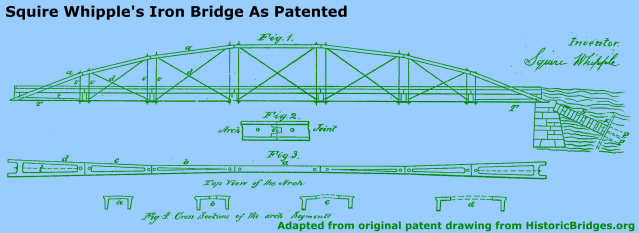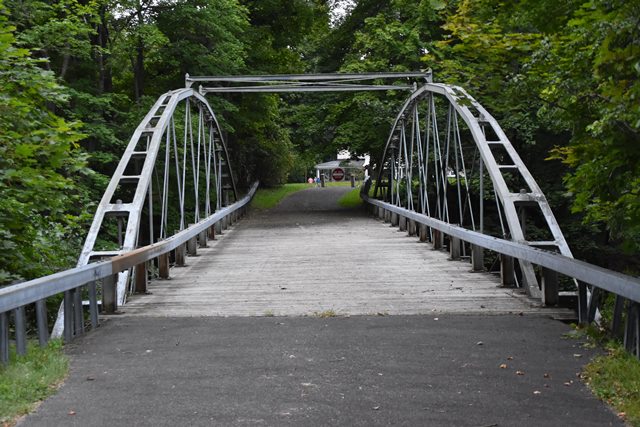We Recommend:
Bach Steel - Experts at historic truss bridge restoration.
BridgeHunter.com Phase 1 is released to the public! - Visit Now
Normans Kill Ravine Bridge
Normanskill Farm Bridge

Primary Photographer(s): Nathan Holth and Rick McOmber
Bridge Documented: April 15, 2011 and September 2, 2019
Albany: Albany County, New York: United States
1867 By Builder/Contractor: Simon DeGraff of Syracuse, New York and Engineer/Design: Squire Whipple
Not Available or Not Applicable
109.8 Feet (33.5 Meters)
113.0 Feet (34.4 Meters)
17.2 Feet (5.24 Meters)
1 Main Span(s)
Not Applicable

View Information About HSR Ratings
Bridge Documentation
View Historic American Engineering Record (HAER) Documentation For This Bridge
HAER Drawings, PDF - HAER Data Pages, PDF
View The National Register of Historic Places Nomination Form For This Historic Bridge
View Squire Whipple's Bowstring Truss Bridge Patent
View Squire Whipple's A Work on Bridge Building
View Squire Whipple's An Elementary and Practical Treatise on Bridge Building
Significance of Whipple Arch Bridges
This bridge is an example of a patented design of bowstring truss invented by famous bridge engineer Squire Whipple. The design was essentially the first type of iron bowstring truss bridge to be built in the United States, and his design's success spawned not only a period of bowstring truss bridge design and construction, but also marked the rise of metal for use in bridge construction in general. Whipple's patented bowstring truss bridges are often called Whipple Arch bridges, the name referring to how Whipple's bridge design actually functions somewhat as an arch bridge. Whipple himself called his bridges "arch-truss" bridges. Bowstring truss bridges are among the rarest surviving type of historic bridge, and Whipple Arch bridges are rare even among bowstring bridges, making each surviving example an exceedingly rare and significant historic bridge. Additional historic significance arises from the fact that these bridges represent the initial development of commonplace metal bridge construction in the United States.
Squire Whipple is also recognized as the first person to correctly calculate the stresses in a truss bridge, a significant landmark in the development the bridge engineering profession. Squire Whipple also authored two texts discussing his engineering findings and his bridge designs. These are important texts in the history of bridge engineering.
Although Whipple patented his bridge design, a variety of bridge builders frequently got away with using his design without paying royalties. Even New York State adopted his design for bridges on the Erie Canal, but did not pay royalties claiming their actions were for the public good. Two examples of standard Whipple Arch plans that were developed for the Erie Canal are shown below. Eventually, the patent expired and Whipple Arch bridges continued to be built by a variety of builders. The result of all of this is that while Squire Whipple is given credit for the design of bridges like this one at Normans Kill, foundries and bridge companies built the bridges without the direct involvement of Squire Whipple. The Normans Kill Ravine Bridge is one such example, having been built by an unaffiliated bridge builder. Whipple was almost certainly not personally involved with any aspect of the Normans Kill Ravine Bridge design or construction.
Significance of Normans Kill Ravine Bridge
In addition to its significance as a Whipple Arch bowstring truss bridge, the Normans Kill Ravine Bridge uses cast iron for the top chord, in addition to the use of cast iron for truss connection assemblies. Bridges that use cast iron for compression members and chords are, regardless of bridge type, among the rarest and most significant bridges in the United States. The Normans Kill Ravine Bridge is even more noteworthy since it also uses cast iron for the floorbeams, a feature almost unheard of among today's few surviving cast iron bridges.
The Normans Kill Ravine Bridge's cast iron floorbeams are truly fascinating. The Historic American Engineering Record drawings of this bridge include a detailed diagram that is worth viewing. Each floorbeam includes a single cast i-beam. Included in this single casting is either half or all of the bottom chord connection assembly, depending on the panel point. The connection assemblies are in their own right complex works of ingenuity, containing all the needed fittings to accept the vertical and diagonal members as well as the bottom chord and lateral bracing rods. In addition, the connection assemblies include an attachment for an iron rod that runs under the i-beam of the floor beam, acting as a post-tensioning rod. The rod is separated from the i-beam by special cast iron blocks that fit into slots on the i-beam. These slots are all part of the same i-beam and bottom chord connection assembly casting.
Despite its age, the Normans Kill Ravine Bridge is also distinguished for its amazing historic integrity. There are no major alterations to the original design or materials of the bridge. In addition, the bridge shows no signs of major deterioration. Many cast iron bridges have cast iron components that are damaged and show cracking and missing pieces, however that is not the case with this bridge.
It is clear that the Norman's Kill Ravine Bridge has multiple areas of national historic significance making it one of the most important historic bridges in the United States. Further, historic bridge expert Eric DeLony included this bridge in a list of potential World Heritage Bridges in his paper A Context For World Heritage Bridges.
Current Status of the Bridge
The bridge and the property it is on was for many part of a private farm. However the farm, bridge, and roadway is today part of the Albany State Police K-9 Training Center. While the training center is a restricted area, and despite intimidating signage about authorized vehicles and such, it appears pedestrians are allowed on the bridge according to another sign at the bridge. It would appear that the bridge is open to pedestrians, however venturing further into the training center grounds is not recommended. The bridge can be accessed a short distance from the public Normanskill Drive. The bridge does appear to serve light traffic for the training center, but a sign indicates that the bridge closes during the winter for historic preservation reasons. Closing the bridge during the winter is a good idea and will protect the bridge from damage and deterioration. It would appear that the future of the bridge, for the time being, is positive.
This bridge is tagged with the following special condition(s): Unorganized Photos
![]()
Photo Galleries and Videos: Normans Kill Ravine Bridge
Bridge Photo-Documentation
Original / Full Size PhotosA collection of overview and detail photos. This gallery offers photos in the highest available resolution and file size in a touch-friendly popup viewer.
Alternatively, Browse Without Using Viewer
![]()
Bridge Photo-Documentation
Mobile Optimized PhotosA collection of overview and detail photos. This gallery features data-friendly, fast-loading photos in a touch-friendly popup viewer.
Alternatively, Browse Without Using Viewer
![]()
Additional Unorganized Photos
Original / Full Size PhotosA supplemental collection of photos that are from additional visit(s) to the bridge and have not been organized or captioned. This gallery offers photos in the highest available resolution and file size in a touch-friendly popup viewer.
Alternatively, Browse Without Using Viewer
![]()
Additional Unorganized Photos
Mobile Optimized PhotosA supplemental collection of photos that are from additional visit(s) to the bridge and have not been organized or captioned. This gallery features data-friendly, fast-loading photos in a touch-friendly popup viewer.
Alternatively, Browse Without Using Viewer
![]()
Maps and Links: Normans Kill Ravine Bridge
This bridge and road are part of Albany State Police K-9 Training Center. However it appears that pedestrians are allowed to walk on the bridge.
Coordinates (Latitude, Longitude):
Search For Additional Bridge Listings:
Bridgehunter.com: View listed bridges within 0.5 miles (0.8 kilometers) of this bridge.
Bridgehunter.com: View listed bridges within 10 miles (16 kilometers) of this bridge.
Additional Maps:
Google Streetview (If Available)
GeoHack (Additional Links and Coordinates)
Apple Maps (Via DuckDuckGo Search)
Apple Maps (Apple devices only)
Android: Open Location In Your Map or GPS App
Flickr Gallery (Find Nearby Photos)
Wikimedia Commons (Find Nearby Photos)
Directions Via Sygic For Android
Directions Via Sygic For iOS and Android Dolphin Browser
USGS National Map (United States Only)
Historical USGS Topo Maps (United States Only)
Historic Aerials (United States Only)
CalTopo Maps (United States Only)







